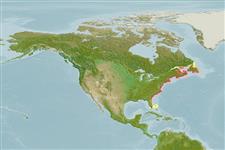Environment: milieu / climate zone / depth range / distribution range
Ökologie
seewasser; brackwasser; ozeanodrom (Ref. 51243); tiefenbereich 0 - 3 m (Ref. 85409). Temperate; 1°C - 33°C (Ref. 35682); 60°N - 25°N, 82°W - 52°W
Western Atlantic: Gulf of St. Lawrence in Canada to northeastern Florida in USA.
Size / Gewicht / Alter
Maturity: Lm ? range ? - ? cm
Max length : 15.0 cm TL Männchen/unbestimmt; (Ref. 7251); common length : 11.5 cm TL Männchen/unbestimmt; (Ref. 12193); max. veröff. Alter: 2.00 Jahre (Ref. 12193)
Afterflossenweichstrahlen: 23 - 26.
Adults feed on copepods, mysids, shrimps, small squids and marine worms (Ref. 7251); also eggs of their own species (Ref. 5951). Preyed upon by striped bass (Ref. 7251) and bluefish (chief predators) (Ref. 5951). Oviparous, eggs are deposited on the substrate during a spawning run along the shore (Ref. 38155). Silversides are sometimes used as live food for trout (Ref. 7251).
Robins, C.R. and G.C. Ray, 1986. A field guide to Atlantic coast fishes of North America. Houghton Mifflin Company, Boston, U.S.A. 354 p. (Ref. 7251)
IUCN Rote Liste Status (Ref. 130435)
Bedrohung für Menschen
Harmless
Nutzung durch Menschen
Fischereien: weniger kommerziell; Aquarium: Kommerziell
Tools
Zusatzinformationen
Download XML
Internet Quellen
Estimates based on models
Preferred temperature (Ref.
123201): 0.7 - 24.5, mean 8.8 °C (based on 225 cells).
Phylogenetic diversity index (Ref.
82804): PD
50 = 0.5039 [Uniqueness, from 0.5 = low to 2.0 = high].
Bayesian length-weight: a=0.00525 (0.00284 - 0.00970), b=3.07 (2.90 - 3.24), in cm total length, based on LWR estimates for this species & (Sub)family-body (Ref.
93245).
Trophic level (Ref.
69278): 3.2 ±0.1 se; based on diet studies.
Widerstandsfähigkeit (Ref.
120179): hoch, Verdopplung der Population dauert weniger als 15 Monate. (K=1.1-1.4; tmax=2).
Fishing Vulnerability (Ref.
59153): Low vulnerability (13 of 100).
Climate Vulnerability (Ref.
125649): Moderate to high vulnerability (50 of 100).
Nutrients (Ref.
124155): Calcium = 131 [75, 340] mg/100g; Iron = 0.858 [0.473, 1.574] mg/100g; Protein = 19 [16, 22] %; Omega3 = 0.507 [0.191, 1.466] g/100g; Selenium = 6.06 [1.98, 15.58] μg/100g; VitaminA = 19.4 [5.3, 76.9] μg/100g; Zinc = 1.22 [0.78, 1.90] mg/100g (wet weight);
